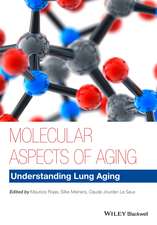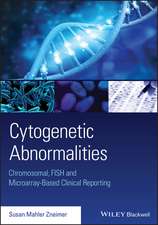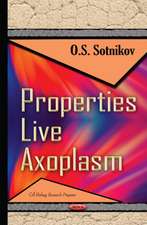Intracellular Delivery: Fundamentals and Applications: Fundamental Biomedical Technologies, cartea 5
Editat de Aleš Prokopen Limba Engleză Hardback – 27 mai 2011
This volume is a collection of authoritative reviews. In the introductory section we define the field (intracellular delivery). Then, the fundamental routes of nanodelivery devices, cellular uptake, types of delivery devices, particularly in terms of localized cellular delivery, both for small drug molecules, macromolecular drugs and genes; at the academic and applied levels, are covered. The following section is dedicated to enhancing delivery via special targeting motifs followed by the introduction of different types of intracellular nanodelivery devices (e.g. a brief description of their chemistry) and ways of producing these different devices. Finally, we put special emphasis on particular disease states and on other biomedical applications, whilst diagnostic and sensing issues are also included.
Intracellular delivery / therapy is a highlytopical which will stir great interest. Intracellular delivery enables much more efficient drug delivery since the impact (on different organelles and sites) is intracellular as the drug is not supplied externally within the blood stream. There is great potential for targeted delivery with improved localized delivery and efficacy.
Preț: 1249.63 lei
Preț vechi: 1523.93 lei
-18% Nou
Puncte Express: 1874
Preț estimativ în valută:
239.14€ • 244.91$ • 198.93£
239.14€ • 244.91$ • 198.93£
Carte tipărită la comandă
Livrare economică 19 martie-02 aprilie
Preluare comenzi: 021 569.72.76
Specificații
ISBN-13: 9789400712478
ISBN-10: 9400712472
Pagini: 1010
Ilustrații: XIX, 867 p. 281 illus., 95 illus. in color.
Dimensiuni: 155 x 235 x 41 mm
Greutate: 1.36 kg
Ediția:2011
Editura: SPRINGER NETHERLANDS
Colecția Springer
Seria Fundamental Biomedical Technologies
Locul publicării:Dordrecht, Netherlands
ISBN-10: 9400712472
Pagini: 1010
Ilustrații: XIX, 867 p. 281 illus., 95 illus. in color.
Dimensiuni: 155 x 235 x 41 mm
Greutate: 1.36 kg
Ediția:2011
Editura: SPRINGER NETHERLANDS
Colecția Springer
Seria Fundamental Biomedical Technologies
Locul publicării:Dordrecht, Netherlands
Public țintă
ResearchCuprins
Editorial and Introduction.- I Mechanisms of uptake and targeting: Mass transport via cellular barriers and endocytosis, Rita E. Serda et al.- Approaches to achieving sub-cellular targeting of bioactives using pharmaceutical nanocarriers , Melani Solomon and Gerard G.M. D’Souza.- Delivery to intracellular targets by nanosized particles: macrophages and RNAs, Gillian Barratt.- The potential and current progress of internalizing molecules in targeted drug delivery, Jiehua Zhou and John Rossi.- Simulation based analysis of nanocarrier internalization, Exciting challenges with a new computational tool, Béla Csukás et al.- Nanosized drug delivery vectors and the reticuloendothelial system, Lisa M. Kaminskas, Ben J. Boyd.- Membrane cross-over by cell-penetrating peptides: kinetics and mechanisms, From model to cell membrane perturbation by permeant peptides, Sandrine Sagan et al.- II Nanocarrier formulation: Intracellular delivery: Multifunctional and modular approach, Rupa Sawant and Vladimir P Torchilin.- Poly(alkyl cyanoacrylate) nanosystems, Julien Nicolas and Christine Vauthier.- Amphiphilic block copolymer based nanocarriers for drug and gene delivery, Xiao-Bing Xiong and Afsaneh Lavasanifar.- Stimuli-responsive polymersomes, Min-Hui Li.- Silica-based nanoparticles for intracellular drug delivery, Sandrine Quignard, Sylvie Masse and Thibaud Coradin.- Magnetic nanoparticles for biomedicine, Ivo Šafařík, Kateřina Horská and Mirka Šafaříková.- Biosynthesis of metalic nanoparticles and their applications, Adam Schröfel and Gabriela Kratošová.- Nanocrystals: production, cellular drug delivery, current & future products, Cornelia M. Keck et al.- Processing and scale-up of polymeric nanoparticles, Christine Vauthier and Kawthar Bouchemal .- III Medical Applications: Magnetic Resonance Tracking of Stem Cells with Iron Oxide Particles, Eddy SM Lee et al.-Nanoparticles for oral administration of cancer therapies, Juan M. Irache et al.- Nanoparticles for photodynamic therapy applications, Laurence Raehm et al.- Nanoparticles for enhanced hyperthermia, Qian Wang and Jing Liu.- Nonviral vectors and their nanoformulations for gene therapy, Jianxiang Zhang et al.- Imaging of Nanoparticle Delivery Using Terahertz Waves, Joo-Hiuk Son et al.- Calcium phosphate- and calcium phosphosilicate-mediated drug delivery and imaging, O.A. Pinto et al.- Nanoparticles for treating intracellular bacteria and protozoa, Maria Jose Morilla and Eder Lilia Romero.- Gene Therapy in Bone Regeneration, A Summary of Delivery Approaches for Effective Therapies, Laura Rose, Ross Fitzsimmons, Tarek El-Bialy and Hasan Uludağ.- Nanoinformatics: developing advanced informatics applications for Nanomedicine, Victor Maojo et al.
Textul de pe ultima copertă
This book features a special subsection of Nanomedicine, an application of nanotechnology to achieve breakthroughs in healthcare. It exploits the improved and often novel physical, chemical and biological properties of materials only existent at the nanometer scale. As a consequence of small scale, nanosystems in most cases are efficiently uptaken by cells and appear to act at the intracellular level. Nanotechnology has the potential to improve diagnosis, treatment and follow-up of diseases, and includes targeted drug delivery and regenerative medicine; it creates new tools and methods that impact significantly existing conservative practices.
This volume is a collection of authoritative reviews. In the introductory part we define the field (intracellular delivery). Then, we first we cover fundamental routes of nanodelivery devices cellular uptake, types of delivery devices, particularly in terms of localized cellular delivery, both for small drug molecules, macromolecular drugs and genes; all at academic and applied levels. Following is dedicated to enhancing delivery via special targeting motifs. Second, we introduce different types of intracellular nanodelivery devices (their chemistry, although the coverage is far from complete) and ways of producing these different devices. Third, we put special emphasis on particular disease states and on other biomedical applications. Diagnostic and sensing is also included.
The intracellular delivery/therapy is a very pregnant topic which will stir great interest. Intracellular delivery enables much more efficient drug delivery since the impact (on different organelles and sites) is intracellular as the drug is not supplied externally within the blood stream. There is a great potential for targeted delivery with improved localized delivery and efficacy.
This volume is a collection of authoritative reviews. In the introductory part we define the field (intracellular delivery). Then, we first we cover fundamental routes of nanodelivery devices cellular uptake, types of delivery devices, particularly in terms of localized cellular delivery, both for small drug molecules, macromolecular drugs and genes; all at academic and applied levels. Following is dedicated to enhancing delivery via special targeting motifs. Second, we introduce different types of intracellular nanodelivery devices (their chemistry, although the coverage is far from complete) and ways of producing these different devices. Third, we put special emphasis on particular disease states and on other biomedical applications. Diagnostic and sensing is also included.
The intracellular delivery/therapy is a very pregnant topic which will stir great interest. Intracellular delivery enables much more efficient drug delivery since the impact (on different organelles and sites) is intracellular as the drug is not supplied externally within the blood stream. There is a great potential for targeted delivery with improved localized delivery and efficacy.
Caracteristici
Comprehensive set of reviews dealing with mechanisms of uptake by cells and tissues Covering several key chemical areas of preparation of nanovehicles Delivers some important application areas in medicine Written by world experts in this field Includes supplementary material: sn.pub/extras

















